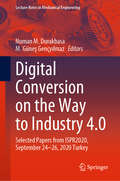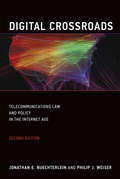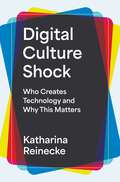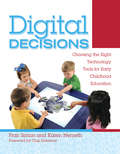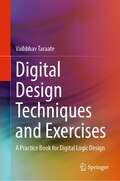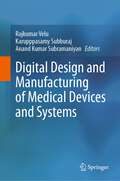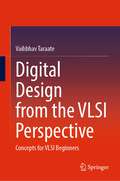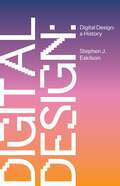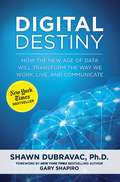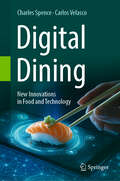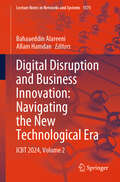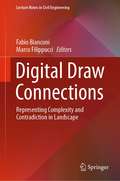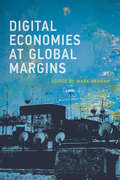- Table View
- List View
Digital Convergence in Contemporary Newsrooms: Media Innovation, Content Adaptation, Digital Transformation, and Cyber Journalism (Studies in Systems, Decision and Control #370)
by George Ghinea Benedito Medeiros Neto Inês AmaralThis book explores the dynamic landscape in contemporary newsrooms across three continents by investigating the impact that the processes of searching, processing, and distributing data and information and the use of big data, with secure, automatic, and agile retrieval of information all have in this context. Journalistic organizations have undergone digital transformations, and only those implementing accurate transformations survive. In so doing, the book addresses the fields of e-Communication, Computer Science, and Information Science and other areas of the authors’ expertise. The first five chapters focus on technical visits to investigate newsrooms’ productive routines and flows in major dailies from Brazil, Costa Rica, and England. The remaining chapters consider that the news production routines are cooperative and distributed and at the same time need to be managed from different perspectives to support the convergence of digital media. Last but not least, the book also identifies an increase in ICT-based tools, with an increasing connection from new media combined with the growing trend of digital economy practices as important factors in the new landscape of digital journalism.
Digital Conversion on the Way to Industry 4.0: Selected Papers from ISPR2020, September 24-26, 2020 Online - Turkey (Lecture Notes in Mechanical Engineering)
by Numan M. Durakbasa M. Güneş GençyılmazThis book presents the proceedings from the International Symposium for Production Research 2020. The cross-disciplinary papers presented draw on research from academics and practitioners from industrial engineering, management engineering, operational research, and production/operational management. It explores topics including: · computer-aided manufacturing; Industry 4.0 applications; simulation and modeling big data and analytics; flexible manufacturing systems; decision analysis quality management industrial robotics in production systems information technologies in production management; and optimization techniques. Presenting real-life applications, case studies, and mathematical models, this book is of interest to researchers, academics, and practitioners in the field of production and operation engineering.
Digital Crossroads, second edition: Telecommunications Law and Policy in the Internet Age
by Jonathan E. Nuechterlein Philip J. WeiserA thoroughly updated, comprehensive, and accessible guide to U.S. telecommunications law and policy, covering recent developments including mobile broadband issues, spectrum policy, and net neutrality.In Digital Crossroads, two experts on telecommunications policy offer a comprehensive and accessible analysis of the regulation of competition in the U.S. telecommunications industry. The first edition of Digital Crossroads (MIT Press, 2005) became an essential and uniquely readable guide for policymakers, lawyers, scholars, and students in a fast-moving and complex policy field. In this second edition, the authors have revised every section of every chapter to reflect the evolution in industry structure, technology, and regulatory strategy since 2005. The book features entirely new discussions of such topics as the explosive development of the mobile broadband ecosystem; incentive auctions and other recent spectrum policy initiatives; the FCC's net neutrality rules; the National Broadband Plan; the declining relevance of the traditional public switched telephone network; and the policy response to online video services and their potential to transform the way Americans watch television. Like its predecessor, this new edition of Digital Crossroads not only helps nonspecialists climb this field's formidable learning curve, but also makes substantive contributions to ongoing policy debates.
Digital Crossroads: Telecommunications Law and Policy in the Internet Age, 2nd ed.
by Jonathan E. Nuechterlein Philip J. WeiserIn "Digital Crossroads," two experts on telecommunications policy offer a comprehensive and accessible analysis of the regulation of competition in the U. S. telecommunications industry. The first edition of "Digital Crossroads" (MIT Press, 2005) became an essential and uniquely readable guide for policymakers, lawyers, scholars, and students in a fast-moving and complex policy field. In this second edition, the authors have revised every section of every chapter to reflect the evolution in industry structure, technology, and regulatory strategy since 2005. The book features entirely new discussions of such topics as the explosive development of the mobile broadband ecosystem; incentive auctions and other recent spectrum policy initiatives; the FCCs net neutrality rules; the National Broadband Plan; the declining relevance of the traditional public switched telephone network; and the policy response to online video services and their potential to transform the way Americans watch television. Like its predecessor, this new edition of Digital Crossroads not only helps nonspecialists climb this fields formidable learning curve, but also makes substantive contributions to ongoing policy debates.
Digital Culture Shock: Who Creates Technology and Why This Matters
by Katharina ReineckeHow culture shapes the design and use of technology—and how we can resist the one-size-fits-all approach to technology designRobots that encroach on your personal space, baffling emojis, a chatbot that gives you an answer that seems terribly rude—does any of this sound familiar? If so, you may know what it feels like to experience a clash of cultures, or even culture shock, in technology. Culture—shared values, norms, and behaviors—influences both the design of technology and its use. An encounter with new technology can teach us to embrace the unfamiliar, but a mismatch between design and user can create misunderstanding and loss of trust, and can even become a tool of digital imperialism. In Digital Culture Shock, computer scientist Katharina Reinecke travels through countries and cultures around the world to show the many fascinating ways that technology design and use can differ.Reinecke argues that technology is inherently cultural because developers apply their own knowledge and experiences when creating it. And this can make the technology fail in other settings. For example, robotaxis trained on driver behavior on a California highway are paralyzed when confronted with the more complicated traffic flows of Egypt. Western online social networks, designed to convey one&’s individuality, violate the need to preserve the image of a family in more group-oriented cultures. Likewise, the visual complexity common in many East Asian websites can be overwhelming to North Americans and European users, who tend to prefer simpler designs. Making it clear what&’s at stake, Reinecke urges us to resist generalizing our own cultural peccadillos in technology design.
Digital Cultures and the Politics of Emotion
by Adi Kuntsman Athina KaratzogianniFifteen thought-provoking essays engage in an innovative dialogue between cultural studies of affect, feelings and emotions, and digital cultures, new media and technology. The volume provides a fascinating dialogue that cuts across disciplines, media platforms and geographic and linguistic boundaries.
Digital Decisions: Choosing the Right Technology Tools for Early Childhood Education
by Chip Donohue Karen Nemeth Fran Simon"Digital Decisions will open your eyes and expand your awareness of how technology fits into a purposefully planned child-centered classroom."- Paula Jorde Bloom, Michael W. Louis Endowed Chair, McCormick Center for Early Childhood Leadership "Simon and Nemeth transform the debate between technology as good or bad, rather showing us how to use technology actively and interactively within good active and interactive early childhood programs." -Ellen Galinsky, Author, Mind in the Making: The Seven Essential Life Skills Every Child Needs Feel confident and competent when it comes to choosing and implementing the most appropriate technology tools for your early childhood classroom! Whether you are a technology enthusiast looking for new ideas and guidance about developmentally appropriate practices, or you are new to the idea of using technology with young children, this book is for you.Digital Decisions provides everything you need to make your own technology plan based on your experiences and beliefs, the needs of the children, the context of your curriculum and the resources available to you. This no-nonsense, jargon-free guide will help you evaluate the tools and opportunities technology has to offer and integrate them into your early childhood classroom so you can offer real-life, hands-on, interactive activities to children. A reference every childhood program will want to have, Digital Decisions is brimming with charts, resources, and an array of activities that maximize technology as an interactive learning tool. Each chapter provides supporting guidance to make technology most effective for those working with children who are dual language learners or may have special needs.
Digital Design Techniques and Exercises: A Practice Book for Digital Logic Design
by Vaibbhav TaraateThis book describes digital design techniques with exercises. The concepts and exercises discussed are useful to design digital logic from a set of given specifications. Looking at current trends of miniaturization, the contents provide practical information on the issues in digital design and various design optimization and performance improvement techniques at logic level. The book explains how to design using digital logic elements and how to improve design performance. The book also covers data and control path design strategies, architecture design strategies, multiple clock domain design and exercises , low-power design strategies and solutions at the architecture and logic-design level. The book covers 60 exercises with solutions and will be useful to engineers during the architecture and logic design phase. The contents of this book prove useful to hardware engineers, logic design engineers, students, professionals and hobbyists looking to learn and use the digital design techniques during various phases of design.
Digital Design and Fabrication (Computer Engineering Series)
by Vojin G. OklobdzijaIn response to tremendous growth and new technologies in the semiconductor industry, this volume is organized into five, information-rich sections. Digital Design and Fabrication surveys the latest advances in computer architecture and design as well as the technologies used to manufacture and test them. Featuring contributions from leading experts, the book also includes a new section on memory and storage in addition to a new chapter on nonvolatile memory technologies. Developing advanced concepts, this sharply focused book— Describes new technologies that have become driving factors for the electronic industry Includes new information on semiconductor memory circuits, whose development best illustrates the phenomenal progress encountered by the fabrication and technology sector Contains a section dedicated to issues related to system power consumption Describes reliability and testability of computer systems Pinpoints trends and state-of-the-art advances in fabrication and CMOS technologies Describes performance evaluation measures, which are the bottom line from the user’s point of view Discusses design techniques used to create modern computer systems, including high-speed computer arithmetic and high-frequency design, timing and clocking, and PLL and DLL design
Digital Design and Manufacturing of Medical Devices and Systems
by Karupppasamy Subburaj Rajkumar Velu Anand Kumar SubramaniyanThis book coherently presents the advances in technological principles, processes, and methods of Additive Manufacturing (AM), Augmented reality (AR), and Internet of things (IoT) in biomedical technology. It offers an overview of these high-impact technologies in terms of materials, processes, and in-situ monitoring of fabricating biomedical devices, implants, and prosthetics. Furthermore, the book also aimed to cover pedagogical applications, including the design and development of high-fidelity anatomical and hybrid physiological human models, for medical and design students and clinicians for learning, understanding, and gaining insights into the structures and functions of human organs and pathology. In turn, the book also discusses the applications of artificial intelligence in the 3-D printing of pharmaceuticals. This book is a useful resource for manufacturers, scientists, engineers, and young research scholars understand disruptive technology's real potential in biomedicalapplications.
Digital Design and Verilog HDL Fundamentals
by Joseph CavanaghComprehensive and self contained, this tutorial covers the design of a plethora of combinational and sequential logic circuits using conventional logic design and Verilog HDL. Number systems and number representations are presented along with various binary codes. Several advanced topics are covered, including functional decomposition and iterative networks. A variety of examples are provided for combinational and sequential logic, computer arithmetic, and advanced topics such as Hamming code error correction. Constructs supported by Verilog are described in detail. All designs are continued to completion. Each chapter includes numerous design issues of varying complexity to be resolved by the reader.
Digital Design from the VLSI Perspective: Concepts for VLSI Beginners
by Vaibbhav TaraateThis volume covers digital design techniques, exercises and applications. The book discusses digital design and implementation in the context of VLSI and embedded system design. It covers basic digital design techniques to high speed design techniques. The contents also cover performance improvement, optimization concepts and design case studies. It includes pedagogical features such as design examples and illustrations. This book will be a useful guide for hardware engineers, logic design engineers, professionals and hobbyists looking to learn and use the digital design to develop VLSI based algorithms, architectures and products.
Digital Design using VHDL: A Systems Approach
by William J. Dally R. Curtis Harting Tor M. AamodtThis introductory textbook provides students with a system-level perspective and the tools they need to understand, analyze and design digital systems. Going beyond the design of simple combinational and sequential modules, it shows how such modules are used to build complete systems, reflecting real-world digital design. All the essential topics are covered, including design and analysis of combinational and sequential modules, as well as system timing and synchronization. It also teaches how to write VHDL-2008 HDL in a productive and maintainable style that enables CAD tools to do much of the tedious work. A complete introduction to digital design is given through clear explanations, extensive examples and online VHDL files. The teaching package is completed with lecture slides, labs and a solutions manual for instructors. Assuming no previous digital knowledge, this textbook is ideal for undergraduate digital design courses that will prepare students for modern digital practice.
Digital Design with RTL Design, VHDL, and Verilog
by Frank VahidIn eagerly anticipated, up-to-date guide to essential digital design fundamentals <P><P>Offering a modern, updated approach to digital design, this much-needed book reviews basic design fundamentals before diving into specific details of design optimization. You begin with an examination of the low-levels of design, noting a clear distinction between design and gate-level minimization. The author then progresses to the key uses of digital design today, and how it issued to build high-performance alternatives to software. <P><P>Offers a fresh, up-to-date approach to digital design, whereas most literature available is sorely outdated Progresses though low levels of design, making a clear distinction between design and gate-level minimization <P><P>Addresses the various uses of digital design today Enables you to gain a clearer understanding of applying digital design to your life <P><P>With this book by your side, you'll gain a better understanding of how to apply the material in the book to real-world scenarios. <P><P>Offers a fresh, up-to-date approach to digital design, whereas most literature available is sorely outdated <P><P>Progresses though low levels of design, making a clear distinction between design and gate-level minimization <P><P>Addresses the various uses of digital design today Enables you to gain a clearer understanding of applying digital design to your life <P><P>With this book by your side, you'll gain a better understanding of how to apply the material in the book to real-world scenarios.
Digital Design: A History
by Stephen EskilsonA groundbreaking history of digital design from the nineteenth century to todayDigital design has emerged as perhaps the most dynamic force in society, occupying a fluid, experimental space where product design intersects with art, film, business, engineering, theater, music, and artificial intelligence. Stephen Eskilson traces the history of digital design from its precursors in the nineteenth century to its technological and cultural ascendency today, providing a multifaceted account of a digital revolution that touches all aspects of our lives.We live in a time when silicon processors, miniaturization, and CAD-enhanced 3D design have transformed the tangible world of cars and coffee makers as well as the screen world on our phones, computers, and game systems. Eskilson provides invaluable historical perspective to help readers better understand how digital design has become such a vibrant feature of the contemporary landscape. He covers topics ranging from graphic and product design to type, web design, architecture, data visualization, and virtual reality. Along the way, he paints compelling portraits of key innovators behind this transformation, from foundational figures such as Marshall McLuhan, Nam June Paik, and April Greiman to those mapping new frontiers, such as Jeanne Gang, Jony Ive, Yugo Nakamura, Neri Oxman, and Jewel Burks Solomon.Bringing together an unprecedented array of sources on digital design, this comprehensive and richly illustrated book reveals how many of the digital practices we think of as cutting-edge actually originated in the analog age and how the history of digital design is as much about our changing relationship to forms as the forms themselves.
Digital Design: Basic Concepts and Principles
by Mohammad A. Karim Xinghao Chen<p>In today’s digital design environment, engineers must achieve quick turn-around time with ready accesses to circuit synthesis and simulation applications. This type of productivity relies on the principles and practices of computer aided design (CAD). Digital Design: Basic Concepts and Principles addresses the many challenging issues critical to today’s digital design practices such as hazards and logic minimization, finite-state-machine synthesis, cycles and races, and testability theories while providing hands-on experience using one of the industry’s most popular design application, Xilinx Web PACK. <p>The authors begin by discussing conventional and unconventional number systems, binary coding theories, and arithmetic as well as logic functions and Boolean algebra. Building upon classic theories of digital systems, the book illustrates the importance of logic minimization using the Karnaugh map technique. It continues by discussing implementation options and examining the pros and cons of each method in addition to an assessment of tradeoffs that often accompany design practices. The book also covers testability, emphasizing that a good digital design must be easy to verify and test with the lowest cost possible. <p>Throughout the text, the authors analyze combinational and sequential logic elements and illustrate the designs of these components in structural, hierarchical, and behavior VHDL descriptions. Coveringfundamentals and best practices, Digital Design: Basic Concepts and Principles provides you with critical knowledge of how each digital component ties together to form a system and develops the skills you need to design and simulate these digital components using modern CAD software.</p>
Digital Destiny: How the New Age of Data Will Transform the Way We Work, Live, and Communicate
by Gary Shapiro Shawn DubravacOur world is about to change.<P> In Digital Destiny: How the New Age of Data Will Change the Way We Live, Work, and Communicate, Shawn DuBravac, chief economist and senior director of research at the Consumer Electronics Association (CEA), argues that the groundswell of digital ownership unfolding in our lives signals the beginning of a new era for humanity. Beyond just hardware acquisition, the next decade will be defined by an all-digital lifestyle and the “Internet of Everything”—where everything, from the dishwasher to the wristwatch, is not only online, but acquiring, analyzing, and utilizing the data that surrounds us. But what does this mean in practice?<P> It means that some of mankind’s most pressing problems, such as hunger, disease, and security, will finally have a solution. It means that the rise of driverless cars could save thousands of American lives each year, and perhaps hundreds of thousands more around the planet. It means a departure from millennia-old practices, such as the need for urban centers. It means that massive inefficiencies, such as the supply chains in Africa allowing food to rot before it can be fed to the hungry, can be overcome. It means that individuals will have more freedom in action, work, health, and pursuits than ever before.
Digital Development in Korea: Lessons for a Sustainable World (Routledge Advances in Korean Studies)
by Myung Oh James F. LarsonDigital Development in Korea explores the central role of digital information and communication technology in South Korea. Analysing the role of ICT in green growth and sustainability, this new edition also demonstrates how concerns over public safety and the Olympic Games, are shaping next generation digital networks. Presenting a network-centric perspective to contextualize digital development politically, economically and socially, and in relation to globalization, urbanization and sustainability, this book builds on firsthand experience to explain the formulation and implementation of key policy decisions. It describes the revolutionary changes of the 1980s, including privatization and color television and the thorough restructuring that created a telecommunications sector. It then goes on to explore the roles of government leadership, international development and education in affecting the diffusion of broadband mobile communication, before weighing up the positive and negative aspects of Korea’s vibrant new digital media. Seeking to identify aspects of the Korean experience from which developing countries around the world could benefit, this book will be of interest to students, scholars and policymakers interested in communications technologies, Korean Studies and Developmental Studies.
Digital Dharma: How AI Can Elevate Spiritual Intelligence and Personal Well-Being
by Deepak ChopraNew York Times bestselling author Deepak Chopra delivers a visionary and unprecedented exploration of how artificial intelligence can revolutionize well-being and open new horizons for personal development.&“AI has the potential to help us create a more peaceful, just, sustainable, healthy, and joyful world. Digital Dharma shows you a path.&”—Sam Altman, CEO of OpenAIIn a world captivated yet bewildered by artificial intelligence, spiritual icon Deepak Chopra, MD, illuminates AI&’s untapped potential to unravel the enigma of consciousness, positioning AI not as a threat but as a catalyst for personal and collective growth. In Digital Dharma, Chopra navigates the balance between technology and expanded awareness, explaining that while AI cannot duplicate human intelligence, it can vastly enhance personal and spiritual growth.Chopra shows readers how the most popular, freely available chatbots can serve as guides through every level of human potential—survival and safety, emotional connection, self-worth, abundance, creativity, wisdom, and the infinite possibilities of cosmic consciousness. AI chatbots offer information, advice, and exploratory avenues of untapped potential about any aspect of human awareness. In practical terms, making AI your ally and guide depends on the art of the prompt, the questions a user poses to a chatbot. As Chopra shows in detail, by asking the right questions, you can bring AI into your inner world, which is where personal growth happens. Chopra provides a personal assessment for you to better understand yourself and exercises to help you expand your awareness in any part of your life.Digital Dharma masterfully helps readers to harness AI, not merely as a technological tool but as a partner in crafting a future where human potential solves the urgent problems facing the planet and each of us as individuals. Deepak Chopra invites us to transcend our limitations and explore a relationship with AI that elevates collective consciousness and personal evolution at the same time.
Digital Dictionary
by Marie Cauli Laurence Favier Jean-Yves Jeannas"Digital age", "digital society", &“digital civilization&”: many expressions are used to describe the major cultural transformation of our contemporary societies.Digital Dictionary presents the multiple facets of this phenomenon, which was born of computers and continues to permeate all human activity as it progresses at a rapid pace. In this multidisciplinary work, experts, academics and practitioners invite us to discover the digital world from various technological and societal perspectives.In this book, citizens, trainers, political leaders or association members, students and users will find a base of knowledge that will allow them to update their understanding and become stakeholders in current societal changes.
Digital Didactical Designs: Teaching and Learning in CrossActionSpaces
by Isa JahnkeAs web-enabled mobile technologies become increasingly integrated into formal learning environments, the fields of education and ICT (information and communication technology) are merging to create a new kind of classroom: CrossActionSpaces. Grounding its exploration of these co-located communication spaces in global empirical research, Digital Didactical Designs facilitates the development of teachers into collaborative designers and evaluators of technology-driven teaching and learning experiences—learning through reflective making. The Digital Didactical Design model promotes deep learning expeditions with a framework that encourages teachers and researchers to study, explore, and analyze the applied designs-in-practice. The book presents critical views of contemporary education, theories of socio-technical systems and behavior patterns, and concludes with a look into the conceptual and practical prototypes that might emerge in schools and universities in the near future.
Digital Dining: New Innovations in Food and Technology
by Charles Spence Carlos VelascoFrom the earliest stone tools to the latest AI-driven innovations, our relationship with food has always been shaped by technology. In &“Digital dining: New innovations in food and technology&”, Charles Spence and Carlos Velasco explore how emerging digital tools and technologies, such as smartphones, 3D printing, artificial intelligence, robots, and extended reality, are transforming the way we prepare, consume, and experience food. Diving into the intersections of tradition and innovation, culture and science, this book offers a thought-provoking journey through the world of gastrophysics and multisensory experience design. Will digital technology enrich our culinary experiences or erode the human touch? With insights from leading experts, real-world applications, and a critical lens on the ethical and cultural implications, this book invites readers to explore the tantalising possibilities and challenges of a rapidly changing food landscape. Whether you are a researcher, food enthusiast, a tech innovator, or a curious thinker, this book will provide you with a new lens to see, taste, and experience the future of food.
Digital Disruption and Business Innovation: ICBT 2024, Volume 2 (Lecture Notes in Networks and Systems #1573)
by Allam Hamdan Bahaaeddin AlareeniThis book examines how organizations across industries are responding to the accelerating pace of technological change, leveraging disruption as a catalyst for growth and competitive advantage. The digital revolution is not merely transforming business operations, it is fundamentally redefining the nature of innovation. Featuring a diverse collection of research, case studies, and expert insights, this book delves into the intersection of digital technologies and business innovation. From artificial intelligence and data analytics to automation and smart platforms, it highlights how emerging tools are driving bold strategies, enhancing customer experiences, and reshaping entire markets. What You&’ll Discover: · Key drivers of digital disruption in today&’s business environment · Innovative responses to change across diverse sectors · Practical frameworks for leading digital transformation ·  
Digital Draw Connections: Representing Complexity and Contradiction in Landscape (Lecture Notes in Civil Engineering #107)
by Fabio Bianconi Marco FilippucciThis book stems from the seminal work of Robert Venturi and aims at re-projecting it in the current cultural debate by extending it to the scale of landscape and placing it in connection with representative issues. It brings out the transdisciplinary synthesis of a necessarily interdisciplinary approach to the theme, aimed at creating new models which are able to represent the complexity of a contradictory reality and to redefine the centrality of human dimension. As such, the volume gathers multiple experiences developed in different geographical areas, which come into connection with the role of representation. Composed of 43 chapters written by 81 authors from around the world, with an introduction by Jim Venturi and Cezar Nicolescu, the volume is divided into two parts, the first one more theoretical and the other one which showcases real-world applications, although there is never a total split between criticism and operational experimentation of research.
Digital Economies at Global Margins (International Development Research Centre)
by Mark GrahamInvestigations of what increasing digital connectivity and the digitalization of the economy mean for people and places at the world's economic margins.Within the last decade, more than one billion people became new Internet users. Once, digital connectivity was confined to economically prosperous parts of the world; now Internet users make up a majority of the world's population. In this book, contributors from a range of disciplines and locations investigate the impact of increased digital connectivity on people and places at the world's economic margins. Does the advent of a digitalized economy mean that those in economic peripheries can transcend spatial, organizational, social, and political constraints—or do digital tools and techniques tend to reinforce existing inequalities?The contributors present a diverse set of case studies, reporting on digitalization in countries ranging from Chile to Kenya to the Philippines, and develop a broad range of theoretical positions. They consider, among other things, data-driven disintermediation, women's economic empowerment and gendered power relations, digital humanitarianism and philanthropic capitalism, the spread of innovation hubs, and two cases of the reversal of core and periphery in digital innovation.ContributorsNiels Beerepoot, Ryan Burns, Jenna Burrell, Julie Yujie Chen, Peter Dannenberg, Uwe Deichmann, Jonathan Donner, Christopher Foster, Mark Graham, Nicolas Friederici, Hernan Galperin, Catrihel Greppi, Anita Gurumurthy, Isis Hjorth, Lilly Irani, Molly Jackman, Calestous Juma, Dorothea Kleine, Madlen Krone, Vili Lehdonvirta, Chris Locke, Silvia Masiero, Hannah McCarrick,Deepak K. Mishra, Bitange Ndemo, Jorien Oprins, Elisa Oreglia, Stefan Ouma, Robert Pepper, Jack Linchuan Qiu, Julian Stenmanns, Tim Unwin, Julia Verne, Timothy Waema

